How to supply water to a private house: arranging a water supply source + supplying water to the house
When wondering how to supply water to a private house, any owner’s ultimate goal is to gain independence from centralized networks and other common water systems located outside the household by equipping an autonomous source.
But often, the installation of such a water intake is the only possible option for providing water to a household. One of the methods of installing an autonomous water supply source and supplying water from it to the house will be discussed below.
The content of the article:
Preparation for water extraction work
Autonomous methods of using water resources have priority in the design and practical implementation of water supply for a private home. When choosing the most optimal solution for arranging a water intake source, it is necessary to take into account the main condition - the presence of an aquifer on the site and its depth, as well as the purposes for which the extracted water will be used.
Therefore, the first and important step in installing a water source of any type will be correct determination of the location of water intake. To do this, one should take into account the absence in the immediate vicinity of the planned source of trees, the roots of which will interfere with the work or will threaten the condition of the water intake in the future, power lines, own or neighboring outbuildings.
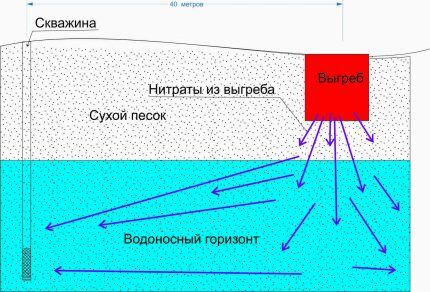
An equally important condition that influences the choice of method of extraction and transportation of water, as well as the location of the source on the property, is the distance from the surface of the earth to the aquifers.
Instructions for constructing a well
The well is one of the most ancient water intake facilities, but has not lost its relevance to this day.
Option with installation of a conventional well in a private home has a number of advantages, the main of which are:
- ease of execution;
- relatively low costs for materials and work;
- no need to obtain permits to use the water supply source.
Well water is obtained from the upper horizons of the soil.
Step 1 - preparatory work
Before constructing a pit for a well, you should decide on the method of strengthening its walls. More often it is reinforced concrete rings, but wooden log houses are also used, less often - brick or natural stone.
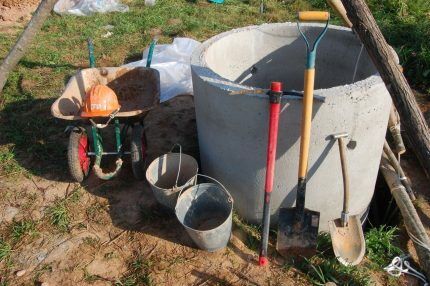
To determine the required number of rings, the depth of the shaft, the density of the soil and its composition, if possible, test drilling is carried out. But a reliable result can only be obtained by digging a mine.
Step 2 - digging a pit
Having decided on the location of the well and the material for the walls, the earth is sampled. Though manual excavation of a pit is physically hard work, but it is with this method, unlike the mechanized one, that greater preservation of the density of the walls is ensured and the required depth of the shaft is achieved.
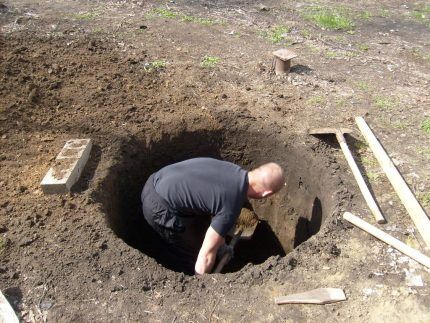
Taking precautions, a ring is placed in the hole, after which four small tunnels are installed under it, in which reliable wooden or brick supports are placed under the ring. When laying the first ring, it is necessary to set its exact verticality. For this, a level or plumb line is used.
Step 3 - installation of rings
After the ring is fixed in place, you can continue to excavate the soil underneath it. The digging is done in such a way that the ring can freely fall under its own weight after removing the supports.

A new ring is placed on top of the ring that has sunk inside the shaft, and the excavation continues to be deepened according to a similar pattern, with a gradual build-up of the structure. To transport the ring to the pit and lay it on the already buried part of the well, you can use a cart whose platform is higher than the part of the ring placed in the shaft protruding above the ground.
The joints of the structure are carefully sealed with tarred hemp and coated with sealant. Additionally, the joints are sealed with concrete mortar.
If the well will be used for drinking water, then it is necessary to go through the top layer of soil and go deep to the second or third aquifer.
Excavation is carried out until abundant water flows into the mine, after which work in the pit is stopped for about a day. If the water in the well rises by more than 1 m during this period, further deepening can be stopped.

Step 4 - installing the bottom filter
Having reached the aquifer, the need for a device is determined bottom filter.
The presence of a filter is mandatory for the following types of well bottom:
- soft clay and is eroded, which is why the water in the bottom part of the well is cloudy;
- sandy — water slowly seeps into the mine;
- at the bottom of the well there is a floater, in the form of muddy streams of sand extremely saturated with groundwater.
There are many materials for constructing a bottom filter.
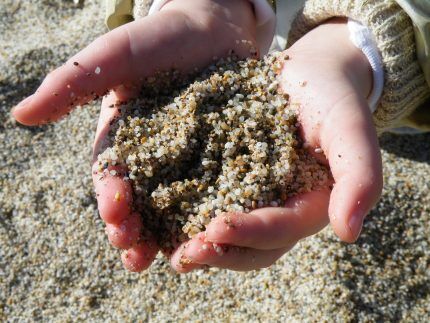
To achieve a greater effect, a three-layer, 30 cm each layer, filtration is arranged. Washed quartz sand serves as the first layer, river pebbles are laid as the second layer, and large stones are poured on top.
To protect against floaters, a bottom filter shield made of boards with holes 1 cm in diameter is installed at the bottom of the well. The shield is wrapped in geotextile, pressed to the bottom with a layer of stones and covered with a layer of small pebbles - 10-15 cm.
Step 5 - arrangement of the above-ground part
Further arrangement of the well consists of filling the gap between the walls of the shaft and the rings with crushed stone or just soil, as well as constructing a clay castle. This ensures that the well is protected from rainwater and other domestic wastewater.
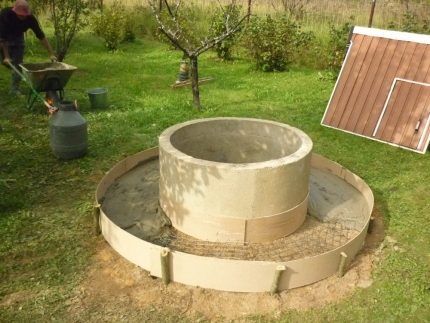
The constructed waterproof castle can be lined with bricks in one row, tiled, or a concrete blind area can be poured, raising it a little higher above ground level.
The work is being completed by equipping the above-ground part of the well. Here everything depends on the imagination and financial capabilities of the owner, but in any case, the well must be protected from rain, snow and dirt.In addition to a regular or decorative roof, it is imperative to build a lid that directly covers the well opening itself, and better yet, with a lock.
Organization of water supply to the house
An ordinary well can also be used as a source of water in the permanent water supply system of a private home.
Therefore, if the old-fashioned method of lifting water from a well - in buckets, with its delivery to the house on a rocker - does not suit the owner of the household, and the water supply is used in the winter, then there is no need to rush into filling the well shaft. The reason is that you will need access to insert a water pipe into the well in its deepened part.
The supply of water from the well to the house is carried out according to the following algorithm.
Stage No. 1 - preparation of tools and materials
At the initial stage, it is necessary to decide on the method of automatically transporting water to the house, outbuildings or for irrigation, as well as what pump will be used for this - submersible or surface.
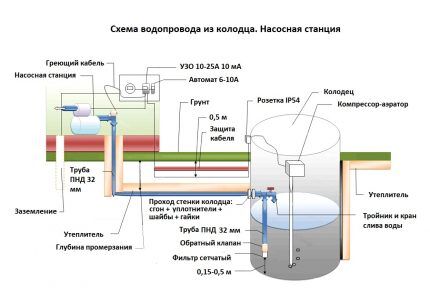
The pump power is selected so that the water pressure in any section of the pipeline is within 1.5 atmospheres, and the performance exceeds the maximum water flow by 25%. In addition, the operation of the pump must be linked to the debit of the source, to prevent air from entering the unit after all the water from the well has been exhausted.
If the water level in the well does not exceed 7 - 10 m, then the optimal solution would be to equip a pumping station with a surface pump.
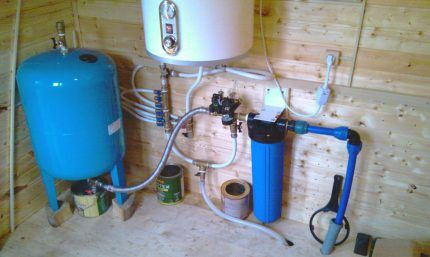
When choosing pipes, you should take into account that the modern method of laying water pipes involves the use of pipe products made of metal-plastic. The most popular are pipes with a diameter of 32 mm.
And, of course, you need to calculate and purchase the necessary set of fittings:
- fitting;
- tees;
- bends;
- adapters.
Compression fittings simplify the process of working with pipes. Their use does not require additional and expensive welding equipment.
Stage No. 2 - arrangement of a trench for pipes
The practical part of arranging the transportation of water to the house begins with digging a trench for laying water pipes.
When choosing the depth of laying communications, the following factors are taken into account:
- the need to install a cushion of sand and gravel mixture at least 10 cm thick at the bottom of the trench;
- depth of soil freezing.
The degree of soil freezing in a particular area can be determined by specialists from the nearest construction organization.

It is recommended to dig a trench to a depth of 30-50 cm below the freezing layer and with a slight slope from the well, about 10 cm per 1 meter of pipe length.
Stage No. 3 - connection to a water supply source
An important stage is the work on arranging the passage of the pipe through the wall of the well.
The mandatory conditions that must be met in this case are:
- The hole for the pipe entry is equipped at the same level at which the water supply lines will be laid.
- The input node should not be placed at the junction of the rings.
A hole is drilled in the concrete ring, usually for an inch cut.
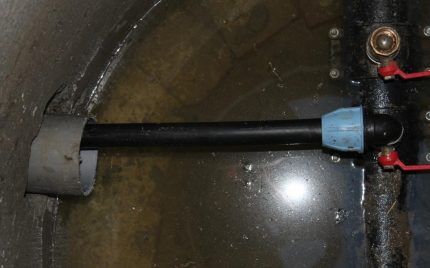
It is also recommended to implement the option of connecting a tee to the internal fitting, on which, in addition to the vertical intake pipe, you can install a drain valve on the horizontal outlet. This will be useful in the case when the house is not used for living in the winter, and the water from the system needs to be drained.
The hole in the concrete ring of the well, into which the through passage is installed, is carefully sealed with a special waterproofing mastic, which contains reinforcing fibers.
Wide rubber gaskets are placed on the same composition, applied to the internal and external walls of the well, on both sides, after which the drive is clamped with nuts and washers.
Stage No. 4 - pipeline installation
Having completed the excavation work and equipped the entrance to the well, you can backfill and compact the remaining gap between the walls of the shaft and the outer walls of the well. Waterproof it and proceed directly to the installation of the water supply system.
Work begins with preparing the intake pipe section.To calculate its length, the fact that water must be drawn from the middle part of the water level in the well is taken into account.

And in order to prevent large suspensions from penetrating into the pipes and pumping station, it would not be superfluous to install a filter on the intake pipe. Ready-made corrugated water intake pipes are available for sale, already equipped with a check valve.
Having equipped the inside of the well, you can begin laying water pipes in the prepared trench - from the well to the house. Here it should be taken into account that a prudent owner will not skimp on additional materials, the use of which will be able to protect against more costly troubles in the future.
Therefore, it is recommended not to simply fill the pipeline with earth, but to carry out some safety measures:
- mechanical protection of pipes;
- pipeline insulation;
- redundancy of communications.
To protect the pipe from soil pressure and other influences, you can use inexpensive technological polyethylene or corrugated pipes.
Both regular corrugated pipes and pipes with insulation are available for sale, which allows you to comprehensively solve the issue of protection and insulation.
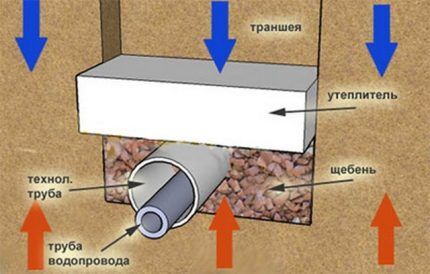
Considering the relatively low cost of plastic pipes, in order to avoid having to carry out labor-intensive work of opening the entire trench, looking for a faulty area and repairing the main, it is recommended to lay a backup water pipe next to the main one.
Stage No. 5 - final work
The final stage of supplying water supply to a house from a well is the installation of a pumping station. It allows you to economically use the resource of such expensive equipment as a pump. Using maximum power when pumping water into hydraulic accumulator, the pump begins to operate in economical mode, squeezing the required amount of liquid into the system.

A check valve is installed at the inlet of the pump to protect the house from flooding from the main pipeline in the event of system malfunctions.
To monitor the pressure of the water supply and automatically, if necessary, turn it off and on, the pump is equipped with an electric contact pressure gauge.
The hydraulic accumulator is installed no lower than 1.5-2 m from the floor level, preferably in the attic, in order to ensure a gravity supply of water during a power outage.
Considering the expensive equipment used, it is advisable to entrust the installation and connection of the pumping station, without special skills, to professionals.
Recommendations for carrying out work
Do not ignore sections of the water supply system where they come to the surface, entrances to the basement of the house or an unheated basement. These areas are subject to enhanced thermal insulation or are equipped with electric heating.
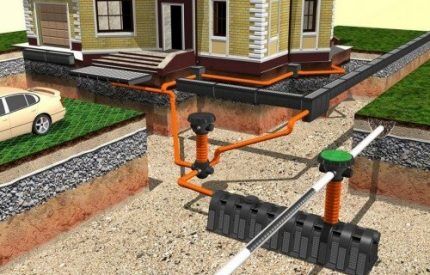
As insulation, a water pipe can be placed in a sleeve made from a sewer pipe with damping polyethylene foam insulation.
For the convenience of possible replacement of the pipe, in places where there are passages through the base or ceiling, it is recommended to insert it through a sleeve made of a larger diameter pipe.
Conclusions and useful video on the topic
Video about the technology of laying rings when constructing a well:
Useful tips for supplying water supply from a well to a house, taking into account the use of water supply in winter:
The option of installing an autonomous source of water supply in your household, the instructions for which are given above, is the most accessible for implementation.
Step-by-step mining tips water and bringing her into the house from the well will allow you to avoid unwanted errors, the correction of which can result in large costs.
If you have had to arrange water supply on your site yourself, please share your experience with visitors to our site. Perhaps there are nuances that need to be paid attention to? Leave your comments in the communication block located under the article.




At our dacha there is a well on the site, but there is also a water supply that comes from the SNT water pump. The hose is connected to the column (or I don’t know what it’s called correctly). It’s convenient to water the garden, but more and more often I’m haunted by the thought that it would be a good idea to bring water into the house - I’m really tired of washing dishes after lunch, sometimes in the rain, or just when it’s cold.I’m thinking, can this same water supply that we have with a hose be brought into the house? Or is it better to leave it for watering the garden and bring it into the house from a well, as described here?
HDPE pipe does not need protection when laid in the ground. But it won’t hurt to put an insulating shell on it. Our trenches are 1.5 m deep. The water pumping station was installed in a concrete underground bunker 2 m deep. I don’t understand why they would put the hydraulic accumulator in the attic. Firstly, in this case, the attic space must be heated so as not to defrost the equipment, and secondly, the hydraulic accumulator is already under pressure. And there's a power outage. As long as there is pressure in the pear, there will be water in the house.
Hello! Tell me where to find a person who can carry out this work?
No problem at all. There is a team of non-drinking workers who dig wells throughout Russia. Prices are competitive, only in the Arctic Circle there is a premium for permafrost.
This is the problem: there is a well, there is a deep-well pump in the well, there is a small concrete place above the well in which there is a hydraulic accumulator, and from it a 32mm pipe goes into the house, about 30 meters away. When you turn on the water in the house, in the bathroom the water first flows with good pressure, and when it practically stops flowing, then the pump turns on and the pressure rises. The pressure in the cylinder is inflated according to the instructions, but there are pressure differences in the house. What's wrong with the system?
You could run the line another 300 meters so that the pressure would be higher